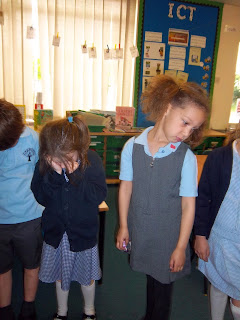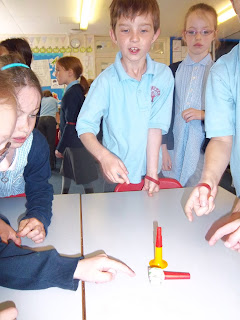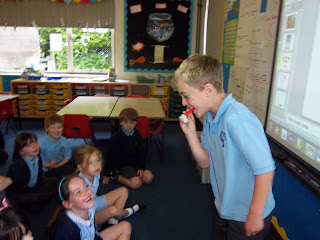Summer Term 2015 RE
In the Summer term, Year 1 turned to learning about Special
Books.
To help us understand how someone might feel about their
Holy Book, we brought in our own favourite books to share with our class. We
explained why they were special to us and how we would want other people to
respect them even if they weren’t special to them!
Then we found out about stories which have been passed on
orally before they were written down. Sometimes these might have been
eye-witness accounts, where the writer has tried to tell the reader what they
felt was the important message behind them. We played some messenger-games
which made us realise that we often remember only the most important parts of
an account. We learned that Jesus had a friend called Peter who gave
eye-witness accounts of what Jesus said and did: these were later written down
and included in the Bible.
We then made our own special Class Book, with a portrait and
information about each member of our class. We discussed how we would make it beautiful,
and how to keep it safe, clean and available to read. We also made up rules so
that visitors would know how to care for it too. We discovered that most faith
communities have special, ‘holy’ books; we found out what these might contain
and how they are treated with respect.
Next, we went on to learn about some of the Holy Books of
different faiths.
We learned
that the Christian Bible is actually a whole library containing 66 books with a
variety of styles! For Christians it is also like a ‘light’ to help them on
their journey through life, and like a ‘letter’ with messages from God. One of
our class pretended to be an Eagle carrying a Bible message to several
countries around the world, then the children in each country passed on the
message they had heard. We had to listen very carefully so that we would
remember it and pass it on accurately!
The
Secretary of State for Education gave our school an enormous Bible, but it was
written in very old English. So we were glad that lots of translations have
been made into modern English that we can understand! When we heard a story
from one of these – about a lost sheep – we suggested our own ideas as to what
the story might want to teach us today.
For
Christians, the most important person in the Bible is Jesus; so we then learned
about an account in the Bible of when Jesus healed a blind man, called
Bartimaeus. We mimed the changing feelings, or ‘stepping stones’, that
Bartimaeus might have experienced as he went from fear to faith.


We also heard an account of when Jesus calmed a storm which was frightening his friends in their boat. We acted out the story, and imagined how we might have felt if we had been there too. We also played a blind-fold game to help us decide what makes someone trust-worthy.


We also heard an account of when Jesus calmed a storm which was frightening his friends in their boat. We acted out the story, and imagined how we might have felt if we had been there too. We also played a blind-fold game to help us decide what makes someone trust-worthy.
Next, we
learned about the Jewish Holy Book, the Torah. One of the children played the
role of the Rabbi, and we all acted out the Simchat Torah celebrations, as if
we had just finished a year’s cycle of reading from the Torah. Learning how
precious the Torah is to Jews reminded us of how we too take great care of the
Class Special Book we made. We then made our own scrolls and wrote in them our
ideas of ‘Guidelines for Living’.
As part of our learning about the Torah, we found out about Moses, who was chosen by God to give the Israelite people his rules, called the 'Ten Commandments'. We thought about how rules in school, and in other areas of life, help to keep us safe and happy. We worked in small groups to devise some rules for games, then played them to test whether they made them fair.
Next, we learned about Muhammad, who is very important to Muslims. We heard the story of how he was given messages from God which he had to remember carefully and pass on to other people. We played some memory games, and discussed what we do to help us remember. Some of us were even able to list thirty items from memory, when playing ‘I went to the market’!
Next, we learned about Muhammad, who is very important to Muslims. We heard the story of how he was given messages from God which he had to remember carefully and pass on to other people. We played some memory games, and discussed what we do to help us remember. Some of us were even able to list thirty items from memory, when playing ‘I went to the market’!
We then went
on to look at a Qur’an on its special stand, and learned why it is special to
Muslims and how it should be treated with respect. We heard a story from the
Qur’an about a Crying Camel, and discussed what that might teach Muslims today.
Our study of
special books then led us to think about song books, poetry and psalms, and how
some people use these to help them worship God. We heard a story from the Bible
about David, who wrote and sang songs, first when he was a shepherd boy, and
later when he became the king. His songs were a form of prayer, so we thought
about why and how people might choose to pray. We heard the Bible account of
when prayers helped to save Daniel from being eaten by lions!
In Year 2, during the Summer term, we have been
focusing on ‘Special Places’.
We began by going way back in time to when people built
stone circles. We tried to solve the ‘Mystery’ of how and why they might be
there. We went outside to re-create the Callanais Stone Circle, using children
as the stones, and acting out some of the folklore stories which have been
passed down through the years. We discussed what it is that makes a place
‘mysterious’, and decided that in RE there are many questions which can be
asked to which even adults don’t have all the answers! We still found it fun to
suggest our own conclusions!
Next, we thought about how some people choose special places
for prayer. We ranked pictures of a range of places according to which we
thought might be most conducive to thinking or prayer. We decided religious
buildings could be helpful, but that quiet places such as deserts, mountains or
gardens might be ideal too. Some of us thought it could even be good to pray in
busy places like markets, playgrounds and even Big Space!
Hearing the Bible story of Martha and Mary helped us focus
on the value some religions place on times of stillness. We sat quietly - or
lay down - to listen to some peaceful music, then drew or wrote about how it
felt to be still and quiet.
The Christian festival of Pentecost took place in May, so we moved briefly away from our ‘Special Places’ topic to find
out what this is about. We learned that this is when Christians celebrate the
Church’s birthday and the time when Jesus’ followers were given the ‘Helper’ he
had promised, known as the Holy Spirit. We went outside to look for signs that
the wind was there. Then we tried out several experiments which needed air or
wind to make them work: even though we couldn’t see the air, we could see what
it did! We learned that Christians believe God’s Spirit is like that: that he
can’t be seen, but that people can see what he does. We thought about how we
could show ‘invisible’ love to people by what we do.
We then went on to look at some places of worship.
First, we prepared for our visit to a synagogue. We thought about how the design of a synagogue
reminds Jews about the years their ancestors spent journeying to their new
‘Promised Land’, and how items in the synagogue are symbols to help them
remember other aspects of their history. We compared a synagogue with other places of
worship we have visited ourselves.
Our visit to St Albans United Synagogue brought our learning
about Judaism to life: we explored the synagogue, looking for the different
features we had learned about beforehand. We also enjoyed looking at
interactive displays about some important Jewish festivals. It became clear to
us that a synagogue is a very Special Place to Jews, and we were so grateful
for the friendly welcome we were given there!
During the Summer term in Reception, we have
continued with our weekly RE story time, hearing stories which link with
topical festivals and values. Our PSHE work, using ‘Jigsaw’, has also enhanced
our learning about values and beliefs.



































































































